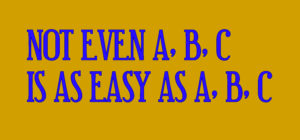I’ve always had an issue with the alphabet song.
A, B, C, D, E, F, G.
H, I, J, K, L-M-N-O-P
Q, R, S (PAUSE)
T, U, V
W, X (PAUSE)
Y AND Z
According to Wikipedia, the song was first copyrighted in 1835 by Charles Bradlee, a Boston-based music publisher, and given the rather (for a simple song) ostentatious title, “The A.B.C., a German air with variations for the flute with an easy accompaniment for the piano forte”.
My issue is with both the metre and the rhyme. They don’t make sense.
The rhyme ends in an “ee” sound.
Which is great for Americans.
But I grew up with the English Zed – an “eh” sound.
So the song always sounded odd trying to rhyme the “zed” with the “Vee”.
The metre, also, seems odd.
1, 2, 3, 4, 5, 6, 7
1, 2, 3, 4, 5-6-7-8-9
1, 2, 3 (PAUSE)
1, 2, 3
1, 2 (PAUSE)
1, 2, 3.
It’s all over the place.
It felt like someone was just making it up. To my English and more pedantic ear, the song would be better with a more regular metre and a rhyme on the “eh” sounds (which are more abundant than would seem at first glance).
Consider this metre
1, 2, 3, 4, 5, 6, 7
1, 2, 3, 4, 5, 6, 7
1, 2, 3, 4, 5, 6, 7
1, 2, 3, 4, 5, 6, 7
And overlay it with the “eh” rhymes found in f, m, s and zed.
“Eh-f” “Eh-m” “Eh-ss” and “Z’eh-d”
And you get…
A, B, C, D, E and F
G, H, I, J, K, L, M
N, O, P, Q, R and S
T, U, V, W, X, Y, Z
It always seemed like a more elegant solution.
The only thing it has against it is the amount of current usage, the popular acceptance of “The A.B.C., a German air with variations for the flute with an easy accompaniment for the piano forte”, cultural intransigence (people like to be right about stuff, and the alphabet song is ALWAYS sung that way) and the limited desire for change (It’s easier to live with a slight mental discomfort – if there is one at all – than to go through the effort of change).
It would take more money than I have to even try and get people to change, even if the “zed” doesn’t rhyme. To own the mental and physical salience (as Uncle Sir Professor Byron so eloquently puts it).
It’s a question any manager of any brand that isn’t number one in its category must ask themselves.
My solution makes perfect sense, why isn’t anyone else buying it?
And the answer is always one of four.
The incumbent number one owns the mental space in people’s heads.
The incumbent number one owns the distribution channels.
The current market is happy enough with the number one’s products.
Any future market isn’t going to pay me enough to recoup my launch costs.
Something to consider next time someone says to you, ‘I’m giving you $10,00,000 to launch this thing. It should be as easy as A, B, C.”


Leave A Comment